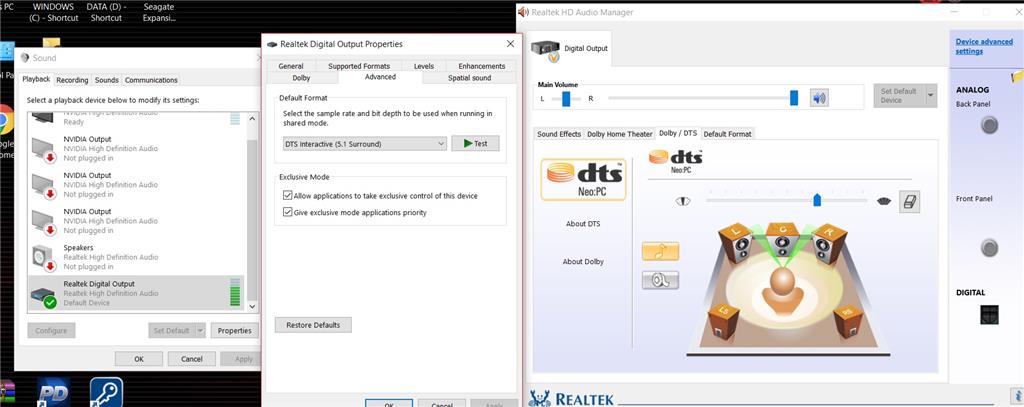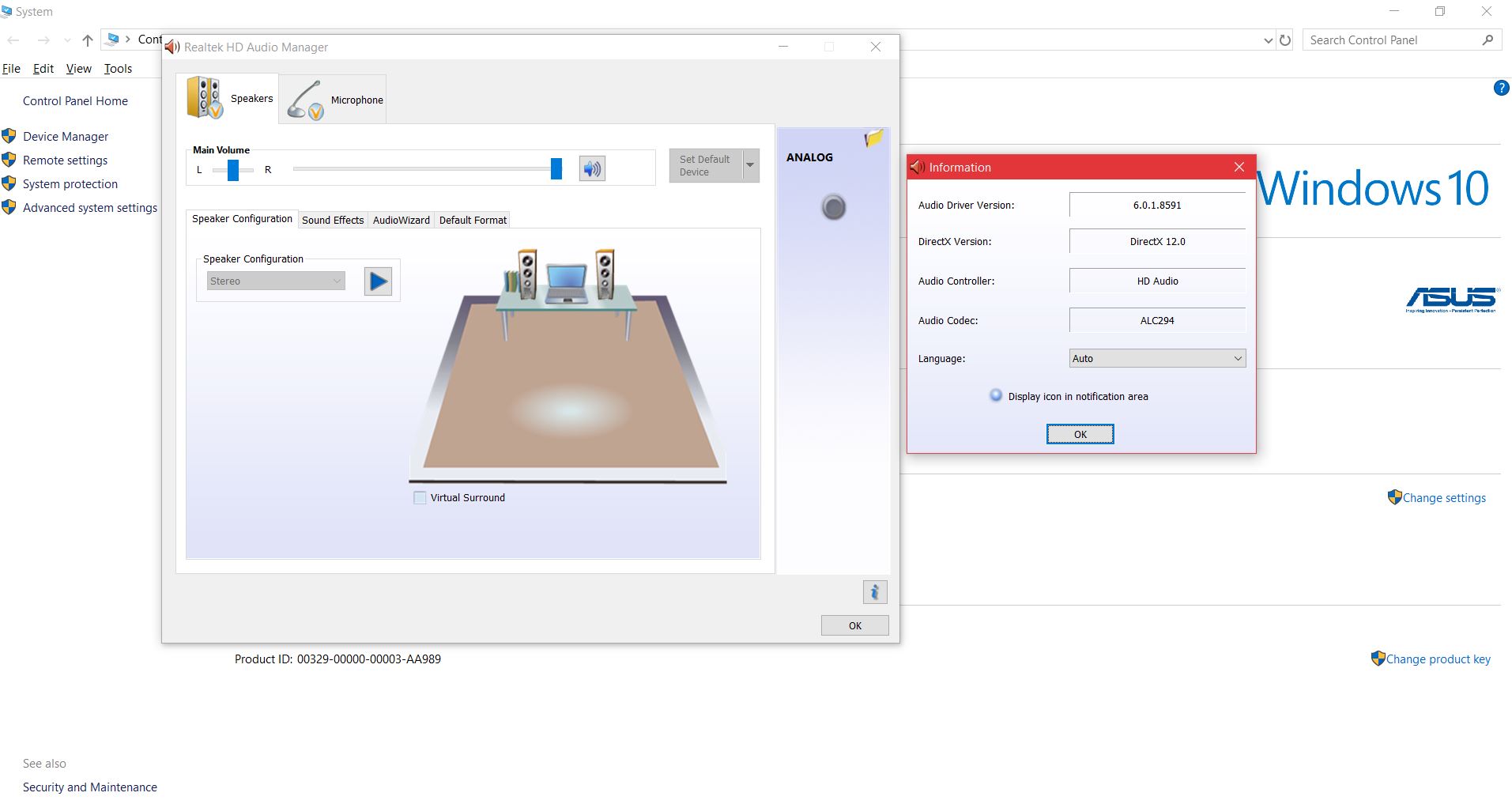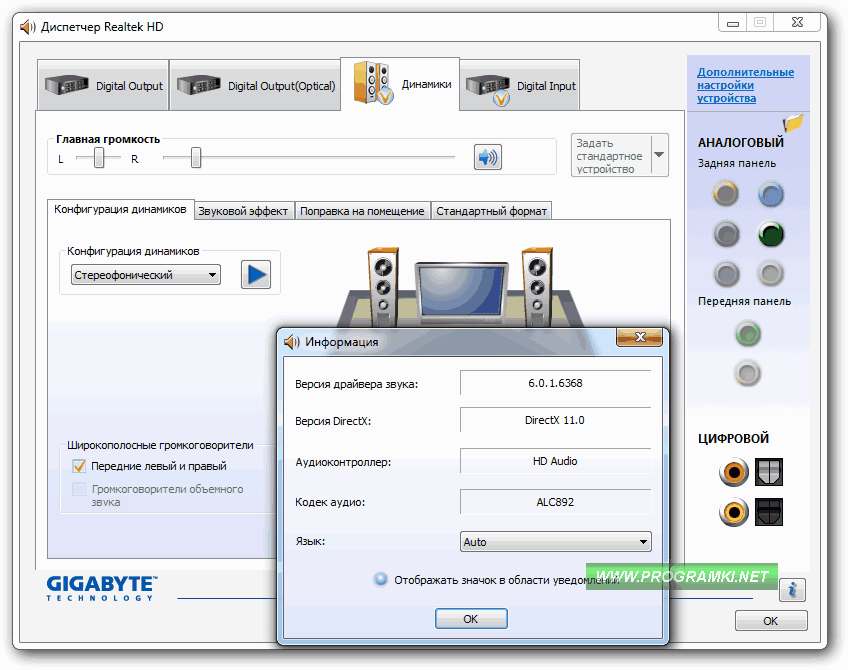3D SoundBack Beta 0.1 (Realtek 3D SoundBack restores audio effects, including surround sound, reverberation, and spatial effects, for legacy game titles when running on. 3D SoundBack Beta 0.1 (Realtek 3D SoundBack restores audio effects, including surround sound, reverberation, and spatial effects, for legacy game titles when running on Windows Vista.) Beta 0.1 2008/07/15 6 MB.
[nextpage title=”Introduction”]
Audio codec is a small chip measuring 0.25 x 0.25 inches (7 x 7 mm) located on the motherboard in charge of the analog audio functions. Knowing the specs of a codec will permit you to compare the audio quality of different motherboards, allowing you to choose the right product for your needs.
For further details on audio codecs, including an explanation of the specs we are publishing, please read our tutorial “How On-Board Audio Works.”
We will separate the codecs according to the manufacturer.
Analog Devices (ADI/SoundMax)
Analog Devices are also known as ADI or SoundMax, and their codecs use names starting with “AD.” In Figure 1, you can see an example of an Analog Devices codec.
Figure 1: Analog Devices AD1988B codec
| Model | Channels | Input Resolution | Output Resolution | Input Max. Sampling Rate | Output Max. Sampling Rate | Input SNR | Output SNR |
| AD1819B | 2 | 16-bit | 16-bit | 48 kHz | 48 kHz | 87 dB | 90 dB |
| AD1881A | 2 | 16-bit | 16-bit | 48 kHz | 48 kHz | 87 dB | 90 dB |
| AD1882 | 5.1 | 24-bit | 24-bit | 96 kHz | 96 kHz | 90 dB | 95 dB |
| AD1884 | 4 | 24-bit | 24-bit | 192 kHz | 192 kHz | 85 dB | 90 dB |
| AD1885 | 2 | 16-bit | 16-bit | 48 kHz | 48 kHz | 87 dB | 90 dB |
| AD1886A | 2 | 16-bit | 16-bit | 48 kHz | 48 kHz | 87 dB | 90 dB |
| AD1887 | 2 | 16-bit | 16-bit | 48 kHz | 48 kHz | 87 dB | 90 dB |
| AD1888 | 5.1 | 16-bit | 20-bit | 96 kHz | 96 kHz | 80 dB | 90 dB |
| AD1980 | 5.1 | 16-bit | 20-bit | 96 kHz | 96 kHz | 82 dB | 90 dB |
| AD1981A | 2 | 16-bit | 20-bit | 48 kHz | 48 kHz | 85 dB | 90 dB |
| AD1981B | 2 | 16-bit | 20-bit | 48 kHz | 48 kHz | 85 dB | 90 dB |
| AD1981BL | 2 | 16-bit | 20-bit | 48 kHz | 48 kHz | 83 dB | 90 dB |
| AD1981BW | 2 | 16-bit | 20-bit | 48 kHz | 48 kHz | 85 dB | 90 dB |
| AD1981HD | 2 | 20-bit | 24-bit | 48 kHz | 48 kHz | 85 dB | 80 to 85 dB |
| AD1983 | 2 | 20-bit | 24-bit | 48 kHz | 48 kHz | 85 dB | 80 to 85 dB |
| AD1984 | 4 | 24-bit | 24-bit | 192 kHz | 192 kHz | 90 dB | 96 dB |
| AD1985 | 5.1 | 20-bit | 20-bit | 96 kHz | 96 kHz | 85 dB | 80 to 90 dB |
| AD1986 | 5.1 | 20-bit | 20-bit | 96 kHz | 96 kHz | 85 dB | 80 to 90 dB |
| AD1986A | 5.1 | 20-bit | 20-bit | 96 kHz | 96 kHz | 85 dB | 80 to 90 dB |
| AD1987 | 7.1 | 24-bit | 24-bit | 96 kHz | 192 kHz | 90 dB | 95 dB |
| AD1988A | 7.1 | 24-bit | 24-bit | 192 kHz | 192 kHz | 90 dB | 95 dB |
| AD1988B | 7.1 | 24-bit | 24-bit | 192 kHz | 192 kHz | 92 dB | 101 dB |
[nextpage title=”Realtek (ALC, Avance Logic)”]
Realtek is probably today’s most popular audio codec manufacturer. Old codecs from Realtek can be found marked as “Avance Logic,” and both old and new codecs use model names starting with “ALC.” In Figure 2, you can see an example of a Realtek codec.
Figure 2: Realtek ALC888S codec
| Model | Channels | Input Resolution | Output Resolution | Input Max. Sampling Rate | Output Max. Sampling Rate | Input SNR | Output SNR |
| ALC101 | 2 | 16-bit | 16-bit | 48 kHz | 48 kHz | 70 dB | 75 dB |
| ALC202 | 2 | 18-bit | 20-bit | 48 kHz | 96 kHz | 85 dB | 90 dB |
| ALC203 | 2 | 18-bit | 20-bit | 48 kHz | 96 kHz | 90 dB | 100 dB |
| ALC250 | 2 | 18-bit | 20-bit | 48 kHz | 96 kHz | 92 dB | 100 dB |
| ALC260 | 2 | 20-bit | 24-bit | 96 kHz | 192 kHz | 90 dB | 95 dB |
| ALC262 | 4 | 20-bit | 24-bit | 96 kHz | 192 kHz | 90 dB | 100 dB |
| ALC268 | 4 | 20-bit | 24-bit | 96 kHz | 192 kHz | 90 dB | 95 dB |
| ALC269 | 4 | 24-bit | 24-bit | 96 kHz | 192 kHz | 98 dB | 98 dB |
| ALC650 | 5.1 | 18-bit | 20-bit | 48 kHz | 96 kHz | 85 dB | 90 dB |
| ALC655 | 5.1 | 16-bit | 16-bit | 48 kHz | 48 kHz | 86 dB | 86 dB |
| ALC658 | 5.1 | 18-bit | 20-bit | 48 kHz | 96 kHz | 92 dB | 96 dB |
| ALC662 | 5.1 | 20-bit | 24-bit | 96 kHz | 96 kHz | 90 dB | 98 dB |
| ALC850 | 7.1 | 16-bit | 16-bit | 48 kHz | 48 kHz | 86 dB | 92 dB |
| ALC861 | 7.1 | 16-bit | 24-bit | 96 kHz | 96 kHz | 82 dB | 90 dB |
| ALC861-VD-GR | 7.1 | 24-bit | 24-bit | 96 kHz | 96 kHz | 85 dB | 95 dB |
| ALC880 | 7.1 | 20-bit | 24-bit | 96 kHz | 192 kHz | 85 dB | 100 dB |
| ALC880D | 7.1 | 20-bit | 24-bit | 96 KHz | 192 KHz | 85 dB | 100 dB |
| ALC882 | 7.1+2 | 20-bit | 24-bit | 96 kHz | 192 kHz | 90 dB | 101 dB |
| ALC883 | 7.1+2 | 24-bit | 24-bit | 96 kHz | 192 kHz | 85 dB | 95 dB |
| ALC885 | 7.1+2 | 24-bit | 24-bit | 192 kHz | 192 kHz | 101 dB | 106 dB |
| ALC887 | 7.1 | 24-bit | 24-bit | 192 KHz | 192 KHz | 90 dB | 97 dB |
| ALC888 | 7.1+2 | 24-bit | 24-bit | 96 kHz | 192 kHz | 90 dB | 97 dB |
| ALC888S | 7.1+2 | 20-bit | 24-bit | 96 kHz | 192 kHz | 90 dB | 97 dB |
| ALC888DD | 7.1+2 | 24-bit | 24-bit | 96 kHz | 192 kHz | 90 dB | 97 dB |
| ALC888S-VC | 7.1+2 | 24-bit | 24-bit | 192 KHz | 192 KHz | 90 dB | 97 dB |
| ALC888-VC2-GR | 7.1+2 | 24-bit | 24-bit | 192 KHz | 192 KHz | 90 dB | 97 dB |
| ALC888S-VD | 7.1+2 | 24-bit | 24-bit | 192 KHz | 192 KHz | 90 dB | 97 dB |
| ALC889 | 7.1+2 | 24-bit | 24-bit | 192 kHz | 192 kHz | 104 dB | 108 dB |
| ALC892 | 7.1+2 | 24-bit | 24-bit | 192 KHz | 192 KHz | 90 dB | 97 dB |
| ALC898 | 7.1+2 | 24-bit | 24-bit | 192 kHz | 192 kHz | 104 dB | 110 dB |
[nextpage title=”C-Media (CMI)”]
C-Media used to be very popular, especially on low-end motherboards, and they manufactured both codecs and complete audio controllers. Audio controllers usually need an external codec to do the analog-to-digital and digital-to-analog conversions, but C-Media’s low-end audio controllers have a codec embedded inside the chip, which is why we will include them in the table below. Because of that, we included a column called “type” to let you know if the chip is just a codec requiring an external controller (e.g., connected to the south bridge chip) or if it is a complete controller with an embedded codec (usually connected to the PCI bus). Chips from C-Media use names starting with the letters “CMI,” as you can see on the example shown in Figure 3.
Figure 3: C-Media CMI9739A codec
| Model | Type | Channels | Input Resolution | Output Resolution | Input Max. Sampling Rate | Output Max. Sampling Rate | Input SNR | Output SNR |
| CMI8738-LX, CMI8738MX | Controller | 5.1 | 16-bit | 16-bit | 48 kHz | 48 kHz | 80 dB | 80 dB |
| CMI8738-SX | Controller | 4 | 16-bit | 16-bit | 48 kHz | 48 kHz | 80 dB | 80 dB |
| CMI8768 | Controller | 7.1 | 16-bit | 24-bit | 48 kHz | 96 kHz | 86 dB | 101 dB |
| CMI9738 | Codec | 4 | 20-bit | 20-bit | 48 kHz | 48 kHz | 72 dB | 82 dB |
| CMI9739 | Codec | 5.1 | 20-bit | 20-bit | 48 kHz | 48 kHz | NA | NA |
| CMI9761 | Codec | 5.1 | 20-bit | 24-bit | 48 kHz | 96 kHz | 90 dB | 92 dB |
[nextpage title=”VIA (VT)”]
VIA manufactures both codecs and complete audio controllers. Their controllers (Envy24 series and Tremor) require an external codec, and usually, the motherboard manufacturer that chooses to use a VIA external controller also picks a VIA codec. Since VIA audio controllers got some popularity in the past, we are including their main specs on a separate table. VIA uses names starting with “VT” for their codecs.
Figure 4: VIA Envy24PT controller (on the right) using a VIA VT1618 codec (on the left)

| Model | Channels | Input Resolution | Output Resolution | Input Max. Sampling Rate | Output Max. Sampling Rate | Input SNR | Output SNR |
| VT1612A | 2 | 20-bit | 20-bit | 48 kHz | 48 kHz | 93 dB | 88 dB |
| VT1613 | 2 | 18-bit | 18-bit | 48 kHz | 96 kHz | 85 dB | 82 dB |
| VT1616 | 5.1 | 20-bit | 20-bit | 48 kHz | 48 kHz | 85 dB | 85 dB |
| VT1617 | 5.1 | 20-bit | 20-bit | 48 kHz | 96 kHz | 85 dB | 95 dB |
| VT1618 | 7.1 | 20-bit | 20-bit | 48 kHz | 96 kHz | 86 dB | 83 dB |
| VT1702S | 4 | 24-bit | 24-bit | 192 KHz | 192 KHz | 98 dB | 100 dB |
| VT1705 | 5.1 | 24-bit | 24-bit | 192 KHz | 192 KHz | 93 dB | 100 dB |
| VT1705CE | 5.1 | 24-bit | 24-bit | 192 KHz | 192 KHz | 93 dB | 100 dB |
| VT1708 | 7.1 | 24-bit | 24-bit | 192 kHz | 192 kHz | 97 dB | 93 dB |
| VT1708A | 7.1 | 24-bit | 24-bit | 192 kHz | 192 kHz | 97 dB | 93 dB |
| VT1708B | 7.1 | 24-bit | 24-bit | 192 kHz | 192 kHz | 98 dB | 95 dB |
| VT1708S | 7.1 | 24-bit | 24-bit | 192 KHz | 192 KHz | 90 dB | 100 dB |
| VT1718S | 7.1+2 | 24-bit | 24-bit | 192 kHz | 192 kHz | 90 dB | 100 dB |
| VT1802P | 4 | 24-bit | 24-bit | 192 kHz | 192 kHz | 98 dB | 100 dB |
| VT1812S | 4 | 24-bit | 24-bit | 192 kHz | 192 kHz | 98 dB | 100 dB |
| VT1818S | 7.1 | 24-bit | 24-bit | 192 KHz | 192 KHz | 98 dB | 100 dB |
| VT1819S | 7.1 | 24-bit | 24-bit | 192 KHz | 192 KHz | 98 dB | 100 dB |
| VT1828S | 7.1+2 | 24-bit | 24-bit | 192 KHz | 192 KHz | 100 dB | 110 dB |
| VT2020 | 7.1+2 | 24-bit | 24-bit | 192 KHz | 192 KHz | NA | 110 dB |
| VT2021 | 7.1+2 | 24-bit | 24-bit | 192 KHz | 192 KHz | 100 dB | 110 dB |
| Model | Channels | Input Resolution | Output Resolution | Input Max. Sampling Rate | Output Max. Sampling Rate |
| Envy24 | 7.1 | 24-bit | 24-bit | 96 kHz | 96 kHz |
| Envy24HT | 7.1 | 24-bit | 24-bit | 192 kHz | 192 kHz |
| Envy24HT-S | 7.1 | 16-bit (AC97)24-bit (I2S) | 16-bit (AC97)24-bit (I2S) | 48 kHz (AC97)192 kHz (I2S) | 48 kHz (AC97)192 kHz (I2S) |
| Envy24GT | 5.1 | 16-bit (AC97)24-bit (I2S) | 16-bit (AC97)24-bit (I2S) | 96 kHz | 96 kHz |
| Envy24MT | 2 | 24-bit | 24-bit | 192 kHz | 192 kHz |
| Envy24PT | 7.1 | 16-bit (AC97)24-bit (I2S) | 16-bit (AC97)24-bit (I2S) | 48 kHz (AC97)192 kHz (I2S) | 48 kHz (AC97)192 kHz (I2S) |
| Tremor | 5.1 | 16-bit (AC97)24-bit (I2S) | 16-bit (AC97)24-bit (I2S) | 48 kHz (AC97)192 kHz (I2S) | 48 kHz (AC97)192 kHz (I2S) |
[nextpage title=”Other Manufacturers”]
There are some other audio codec manufacturers, but codecs from them are rarely seen on motherboards. A good example is Cirrus Logic, a company that manufactures very high-end codecs used mainly by home theater receivers. One of their codecs, CS4382, was used on a few very high-end motherboards from MSI (K8N Diamond Plus and K9N Diamond Plus, for example), providing a state-of-the-art audio quality for these products (signal-to-noise ratio of 114 dB). In the past, they also provided low-end audio codecs and controllers using the brand “Crystal.” Cirrus Logic and Crystal products start with the letters “CS.”

Figure 5: Cirrus Logic CS4382 codec and Creative Labs controller on an MSI K9N Diamond Plus motherboard
Another popular controller/codec manufacturer from the past was ESS, which had chips starting with the letters “ES.”
Realtek Alc1220 Codec Vs Realtek Alc892 Audio Codec Driver Download

Realtek Alc1220 Codec Vs Realtek Alc892 Audio Codec Usb
Another brand that you can see around is IDT.